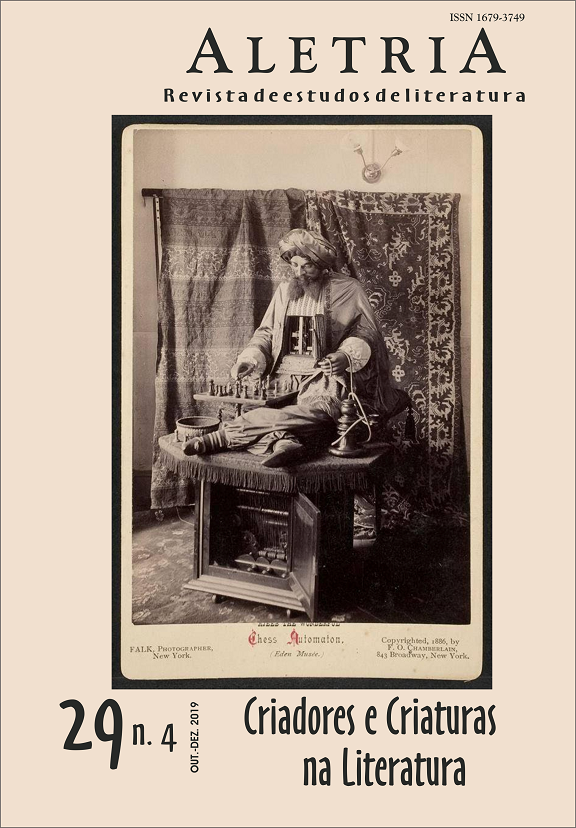“Dearest Reader, It’s Up to You”: Articulating the Theory of Aesthetic Response and Metafiction in Ian McEwan’s Sweet Tooth
DOI :
https://doi.org/10.17851/2317-2096.29.4.141-164Mots-clés :
theory of aesthetic response, implied reader, metafiction, parody, mise en abyme, Ian McEwan, Sweet ToothRésumé
In this paper, we aim at discussing the figure of the reader and the reading processes in Ian McEwan’s novel Sweet Tooth. To do so, we propose an articulation between the theoretical discourses on metafiction and the theory of aesthetic response. Drawing from theoretical frameworks elaborated mainly by Iser (1972, 1978, 1989, 2006) – regarding the theory of aesthetic response – and by Hutcheon (1980, 2000) and Waugh (1984) – regarding metafiction – we understand parody and mise en abyme as two metafictional procedures that constitute the structure of the implied reader. In this sense, if these metafictional creative strategies make the reading activity more complex, they also function as guiding systems to the reader, allowing him to pursue answers to the enigmas articulated within the novel. Parody and mise en abyme, for McEwan, are powerful tools in what we might perceive as a project to develop more proficient readers.
Téléchargements
Références
DÄLLENBACH, Lucien. El relato especulado. Translated by Ramón Buenaventura. Madrid: Visor, 1991.
DOBIE, Ann B. Theory into Practice: An Introduction to Literary criticism. 3. ed. Boston: Wadsworth, 2012.
HOLUB, Robert C. Constance School of Reception Aesthetics [Reception Theory]. In: MAKARYK, Irena R. (org.). Encyclopedia of Contemporary Literary Theory: Approaches, Scholars, Terms. Toronto: University of Toronto Press, 1993. p. 14 -18. DOI: https://doi.org/10.3138/9781442674417-006.
HUTCHEON, Linda. A Theory of Parody: The Teachings of Twentieth-Century Art Forms. Urbana; Chicago: University of Illinois Press, 2000.
HUTCHEON, Linda. Narcissistic Narrative: The Metafictional Paradox. Waterloo: Wilfrid Laurier University Press, 1980.
ISER, Wolfgang. How to Do Theory. Oxford: Blackwell, 2006.
ISER, Wolfgang. Prospecting: From Reader Response to Literary Anthropology. Baltimore: John Hopkins University Press, 1989.
ISER, Wolfgang. The Act of Reading: A Theory of Aesthetic Response. Baltimore: John Hopkins University Press, 1978.
ISER, Wolfgang. The Reading Process: A Phenomenological Approach. New Literary History, Baltimore, MD, v. 3, n. 2, p. 279-299, 1972. DOI: https://doi.org/10.2307/468316.
KORKUT, Nil. Kinds of Parody: From the Medieval to the Postmodern. 2005. 185 f. Thesis (Doctorate of Philosophy in English Literature) – Graduate School of Social Sciences, Middle East Technical University, Ankara, 2005.
LODGE, David. The Art of Fiction. New York: Viking, 1993.
MARCUS, Laura. Detection and Literary Fiction. In: PRIESTMAN, Martin (org.). The Cambridge Companion to Crime Fiction. Cambridge: Cambridge University Press, 2003, p. 245-267.
McEWAN, Ian. Sweet Tooth. London: Vintage, 2013.
McEWAN. Ian. The Guardian – Interview Ian McEwan – Sweet Tooth. [Interview conceded to] John Mullan. [S. l: s. n.], 2015. 1 video. (36:22 min). Published by channel Oswaldo Armendariz. Available at: https://www.youtube.com/watch?v=b53AyL87gLk. Retrieved on: 30 May 2017.
MERIVALE, Patricia. Postmodern and Metaphysical Detection. In: RZEPKA, Charles; HORSLEY, Lee (org.). A Companion to Crime Fiction. Malden: Wiley-Blackwell, 2010. p. 308-320. DOI: https://doi.org/10.1002/9781444317916.ch24.
NEUMANN, Birgit; NÜNNING, Ansgar. Metanarration and Metafiction. 2014. Available at: http://www.lhn.uni-hamburg.de/article/metanarration-and-metafiction. Retrieved on: 10 Aug. 2019.
PIGLIA, Ricardo. O último leitor. Tradução de Heloisa Jahn. São Paulo: Companhia das Letras, 2006.
RITA, Annabela. Mise en abyme. In: CEIA, Carlos (org.). E-dicionário de termos literários. 2010. Available at: http://edtl.fcsh.unl.pt/encyclopedia/mise-en-abyme/. Retrieved on: 13 Aug. 2019.
RON, Moshe. The Restricted Abyss: Nine Problems in the Theory of mise en abyme. Poetics Today, Duhan, NC, v. 8, n. 2, p. 417-438, 1987. DOI: https://doi.org/10.2307/1773044.
WAUGH, Patricia. Metafiction: The Theory and Practice of Self-Conscious Fiction. London; New York: Routledge, 1984. DOI: https://doi.org/10.2307/1771928.
Téléchargements
Publiée
Numéro
Rubrique
Licence
(c) Copyright Caio Antônio Nóbrega, Genilda Azerêdo (Autor) 2019

Ce travail est disponible sous la licence Creative Commons Attribution 4.0 International .
Authors who publish with this journal agree to the following terms:Authors retain copyright and grant the journal right of first publication with the work simultaneously licensed under a Creative Commons Attribution Non-Commercial No Derivatives License that allows others to share the work with an acknowledgement of the work's authorship and initial publication in this journal.Authors are able to enter into separate, additional contractual arrangements for the non-exclusive distribution of the journal's published version of the work (e.g., post it to an institutional repository or publish it in a book), with an acknowledgement of its initial publication in this journal.Authors are permitted and encouraged to post their work online (e.g., in institutional repositories or on their website) prior to and during the submission process, as it can lead to productive exchanges, as well as earlier and greater citation of published work (See The Effect of Open Access).









